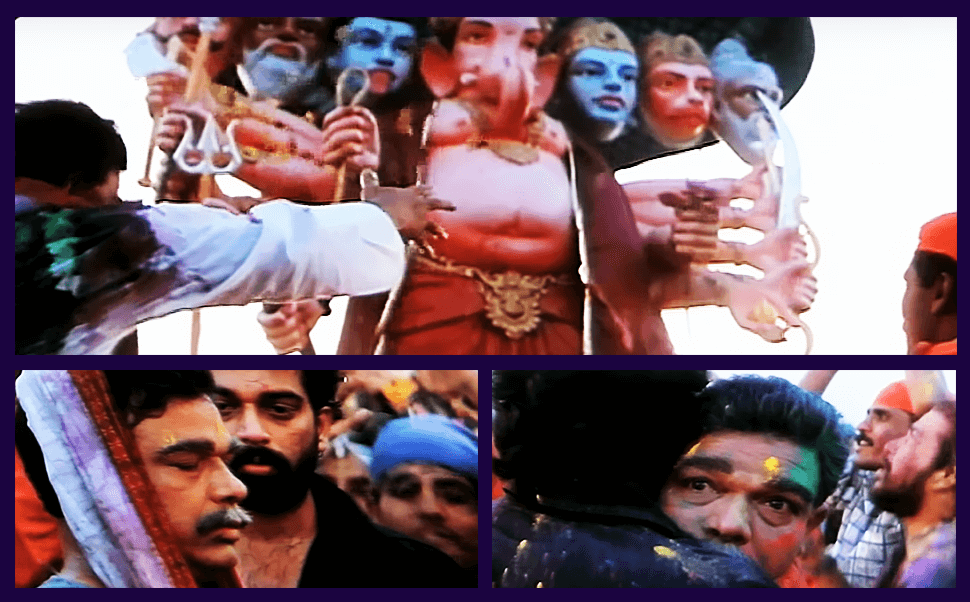10 Movie Scenes That You Didn’t Know Had A Hidden Meaning
[/vc_column_text][/vc_column][/vc_row][vc_row full_width=”stretch_row_content_no_spaces” gap=”35″][vc_column width=”2/12″ css=”.vc_custom_1561015863493{padding-right: 20px !important;padding-left: 20px !important;}”][/vc_column][vc_column width=”6/12″][vc_column_text css=”.vc_custom_1566976572152{margin-bottom: 100px !important;}”]Movie viewing experience has become very dynamic, the technology has developed, the content has improved and even the audiences have evolved. But as a viewer amidst all these advances what we still value the most are the moments in the movies that make you pause the film and then ponder about it for a while. The scene might be having hidden subtexts, some trivia around the film, an inside joke, a crossover reference, juxtaposing two situations or even a frame with scope of viewer’s interpretation. With this thought itself we aimed to develop a series called #PausedOnPurpose where we bring to you some moments from films that have been crafted specially and need a revisit to acknowledge the geniuses that lie beneath.1. Gully Boy (2019)

These scenes have been #PausedOnPurpose to capture the brilliant detailing in the characterization of Muraad and Safeena (from #Gullyboy) through a metaphor. These frames indirectly speak a lot about their narratives.
In these scenes, both of them are reluctant to walk side by side with their respective mothers (in the case of Murad, it’s his stepmother). The mothers can be perceived as metaphors for the mess in their life, giving the viewers an impression that they are walking away from those problems both figuratively and literally.
Zoya Akhtar’s visual language has been top notch and very expressive in this film. Even in these frames we can see a contrast between their problems. In Murad’s frame, there’s action, noise, people around, just like how his life has been in his gully, full of people and liveliness – but still incomplete.
In Safeena’s frame there is a monotonous off-whitish background with no one around them, just like her life, complete and peaceful from what it appears but hollow from the inside. Remember, she doesn’t have a single friend shown in the movie except for her mutual friends with Murad, which is a testament to her lack of social life because of forced conservatism.
Both these characters want to break out and escape from their worlds of problems and are trailing for it, but till that time they have each other to make this chaos a little more bearable.
2. Piku (2015)
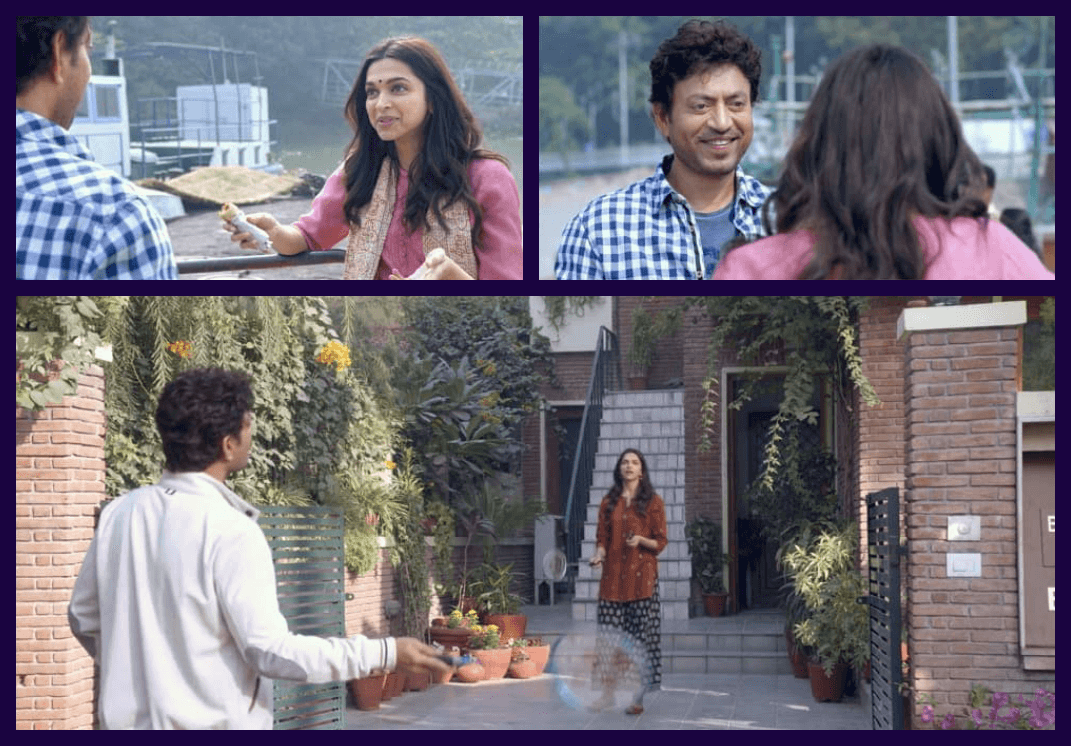
The frames were #PausedOnPurpose to ponder upon a very simple yet striking thought. You would’ve questioned yourself “hang on, are Rana and Piku a thing or not?”. And if this question crosses the viewer’s mind then there lies the victory of the genius filmmaker Shoojit Sircar, who should be given due credit for it.
In Indian cinema, there’s been a trend of depicting love and romance in a particular template. There have been some over the top romantic sequences, sometimes borderline and sometimes out and out cheesy expressions of romance, due to which beauty of subtlety becomes really rare. But Sircar dares to deviate from it through and through in the film.
In the film there are several subtle scenes when cute glances and stares are shared between Rana & Piku, they seem to grow an organic bond, and there are also scenes when Bhaskor (Amitabh Bachchan) goes in the background and the focus is on the little yet very expressive moments that they share. One such moment is shown in the upper images, where Piku says that whoever wants to marry her will have to adopt her 90-year-old baby (Bhaskor) and then jokingly asks Rana, “Can you take the pain of marrying me” to which Rana replies “Do you think I have lost it, to do something like this” and both share a laugh.
All of this does hint the viewers that there is some chemistry building between both of them but right till the end Sircar avoids to explicitly define their relationship. In the last scene, they are just shown playing badminton casually, which again doesn’t spoon feed any perception and leaves the viewers to think it their way.
Couple or not a couple, does it really matter? If it’s beautiful then let it be its own kind of beautiful, that’s what Mr. Sircar teaches us through this interesting journey of Rana & Piku’s companionship.
3. Swades (2004)

B-I-J-L-I
When you hear this word from the mouth of the wrinkly old woman in her hoarse voice, everyone rejoices, even you as a viewer can’t help but feel the happiness of the villagers of Charanpur. After the 12 minute long scene of Mohan with a bunch of enthusiastic villagers trying to generate electricity through hydropower, we see all the tension getting released through this scene.
The beauty of this scene lies in the way Gowarikar has used this bulb. It was symbolised very beautifully and we as viewers could perceive it in certain ways. Bulb is widely known as the symbol of innovation. It’s considered as one of the most important inventions in the history of mankind. When the bulb gets lit up, there are several other hopes that light up – hope of innovation, hope of development & hope of the much needed change in the lives of the people of Charanpur.
The usage of lights has been very evident throughout the film, in different ways, even in the lyrics of the song “Ye Tara Woh Tara”, there is description of starlight after they face a power cut during a film viewing.
Another important scene which should not be missed is of Mohan confronting the villagers that they have started to accept their fate without the electricity and have got used to the darkness (metaphorically & literally). Mohan steps up by taking the charge to make them independent by generating their own electricity and shows the sign of being their guiding light in the darkness.
These are the simple little things that Gowarikar has taken care of to pour the emotion and feels of the people of charanpur and make us question ourselves as to what we intend for our country, our people.
4. Andhadhun (2018)
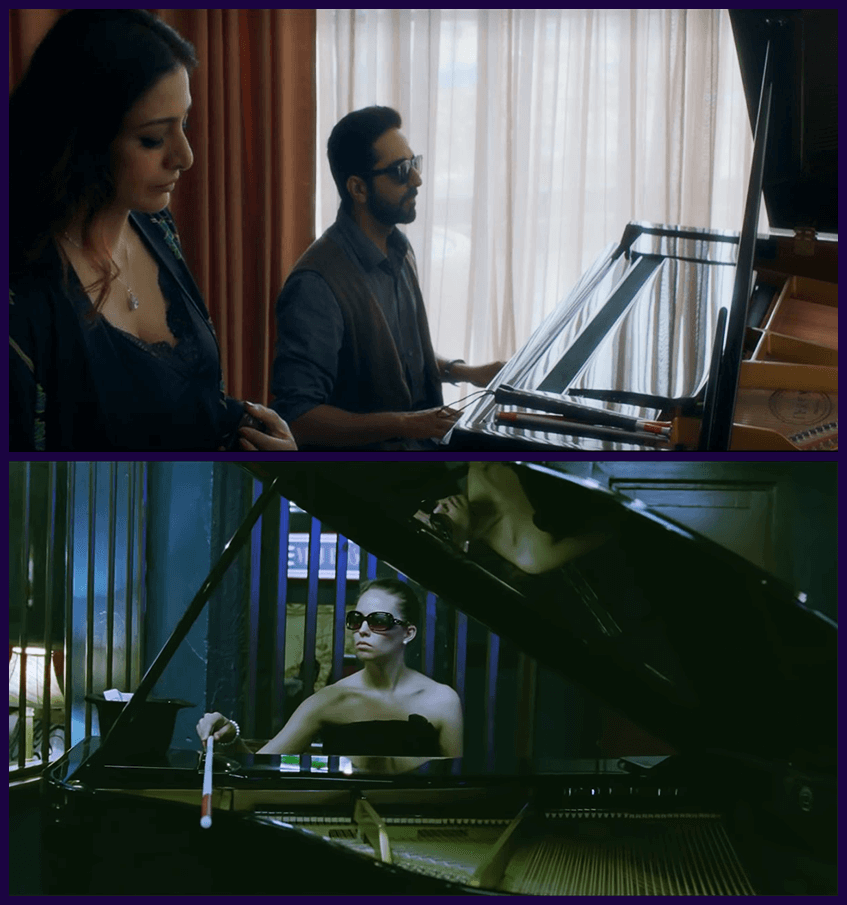
A blind person beautifully playing the piano with a lot of chaos around, sounds like a scene from Andhadhun (2018), right? But guess what, director Sriram Raghavan had created a similar scene in the uniquely shot action-sequence in one of his earlier directorial ventures Agent Vinod (2012). It had the song “Raabta” playing in the background.
In both the scenes the filmmaker has ensured that there is tension and a sense of rush through the visuals, but at the same time there is an element of poise with the musicians keeping their calm and doing their job silently.
5. Barfi! (2012)
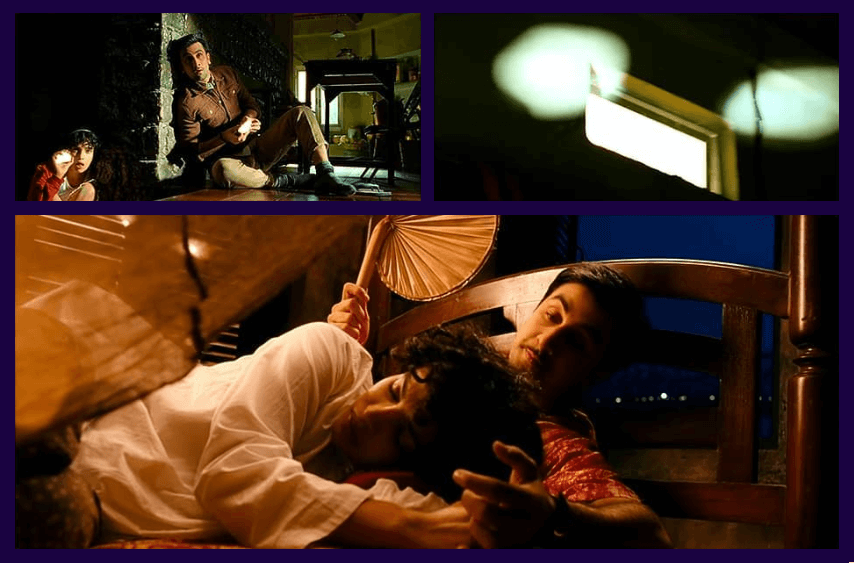
“Barfi adhoora tha, par uska pyaar pura tha”
This line truly encapsulates how love and the expression of it has been depicted in this film.
They say that to express your love it is important to use maximum of your senses & abilities, but Barfi & Jhilmil defy all these ideas and notions to prove them wrong. Both of them collectively miss out on the privilege of speaking, listening and touching at times (because of the authentic portrayal of Jhilmil’s autism) and still manage to be hopelessly romantic for each other.
Jhilmil has been shown as the victim of a really selfish and unempathetic family, and with her condition she needs utmost empathy and care. In the song “Sawli Si Raat”, the scene where Barfi beautifully connects with jhilmil over a simple reflection in the mirror, that’s all he needs with a chaplin-esque puppetry act. Probably that’s how Barfi is, he doesn’t know how to complicate things, he is just a golden-hearted gem who knows how to give love limitlessly.
Through the other frame we can observe how the physical touch between both of them has been shown minimal throughout the film. But still the pinky finger lock between them manages to feel more heavenly than some of the warmest hugs shown on screen.
If there’s a class on how to love like Barfi does, then we’d enroll there for a lifetime.
6. Dear Zindagi (2016)
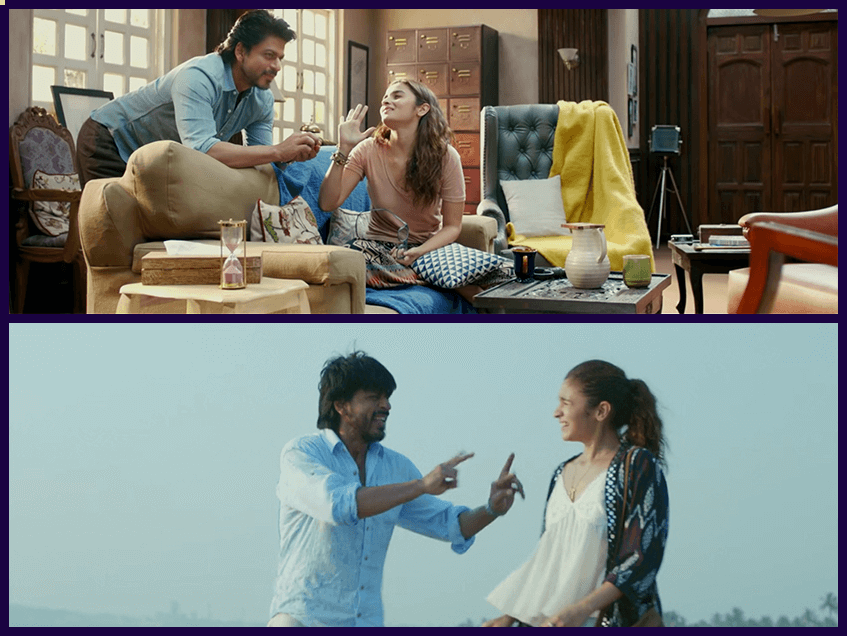
Both these scenes have a very interesting similarity.
Kaira and Jehangir can’t seem to get enough of what they are enjoying.
Kaira is shown taking therapy sessions from Jehangir. In the initial sessions she is shown having a ton of pre-conceived notions and seems to be in an uneasy space of mind because of her circumstances. But as the sessions progress, it grows on her and she develops a liking for therapy, so much so that she would every time want to extend the session for a little bit longer because of how great she feels.
On one occasion, Jehangir decides to take a beachside session breaking the rules of therapy because he had a very special memory attached to the beach – playing ‘kabbadi’ with the waves. We see a child-like energy and zeal on Jehangir’s face which is infectious to Kaira as well. We can see him very innocently insisting to play for a couple of more rounds as he wants to extend this very special brief moment. It almost feels like it’s therapeutic to Jug.
This clearly tells us that how much ever mentally tough someone appears to us, they do have a tendancy to flow into something that is really special to them and feel like they can’t get enough of it.
7. Masaan (2015)
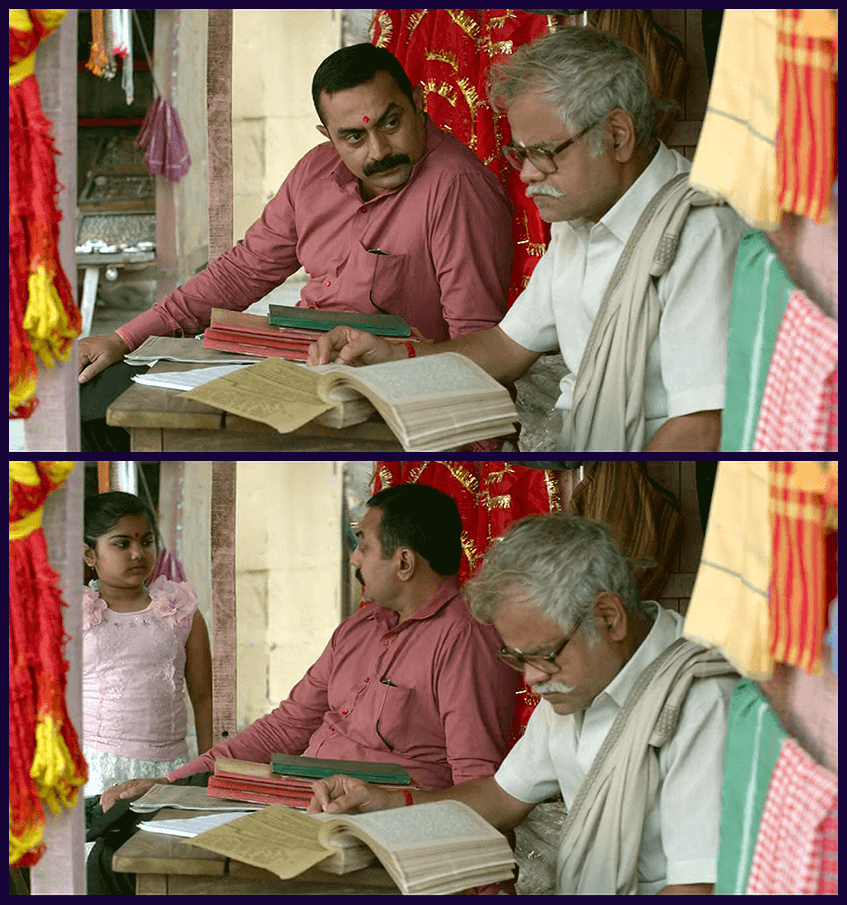
These frames have been analysed to point out a subtle yet strong nuance that the makers want to communicate. In this scene, the inspector comes to give the not-so-gentle reminder to Vidyadhar Pathak to pay the remaining amount of the bribe. The piercing words and brutal stare at Pathak just tells us how intimidating the inspector could be, cut to the next frame when a little girl enters saying “Papa, chale?”
For all this while, the inspector was shown threatening and warning Pathak to pay the remaining amount of bribe so as to not make the intimate videos of Pathak’s daughter public. Pathak is shown helpless and struggling to gather the money, but he still tries his best to save himself and his daughter from the consequences. Suddenly, when you see the inspector’s daughter for a few seconds (her only scene in the film), you realize that such films justify the saying “every frame and every scene has to have an intention”. After seeing the inspector sweetly affirming to his daughter saying “Haan, chalo”, in that moment it feels like irony died a painful death.
The appearance of the inspector’s daughter in that frame for only a few seconds was a purposeful device to highlight the irony of the situation and to show the two-faced nature that humans carry. And who knows if later on, life could have come full circle for the inspector in the future. But great films never serve anything easily, and this piece of greatness is no different.
8. Monsoon Wedding (2001)
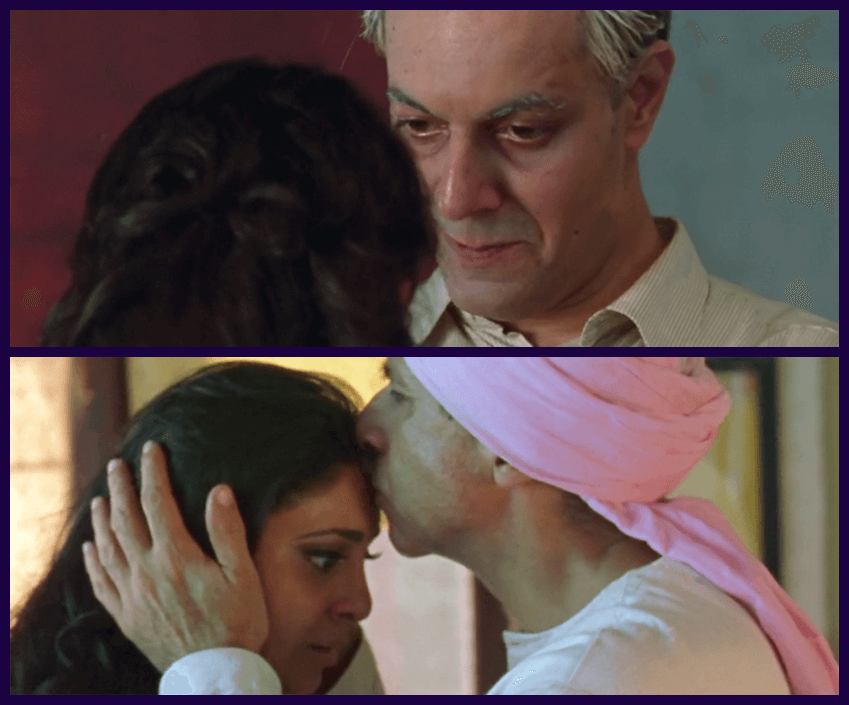
Mira Nair’s Monsoon wedding is one of the most layered Hindi films we have ever watched – there are many subplots and even little moments in the films are a commentary in itself on various issues ranging from class divide to child abuse to censorship and many more.
Here are two situations that we have analysed to juxtapose and highlight how filmmakers convey similar moments with different kinds of environments and messages. The film in the first half has a scene with Tej Puri (Rajat Kapoor) kissing Riya (Shefali Shah) on her forehead. Kissing on the forehead is considered as one of the warmest gestures there is, which symbolizes love and security. The scene was shot to make it look plain and emotionless purposely as it is not supposed to be a comforting scene and the filmmaker wants to treat this scene with just that blandness. The scene also establishes in the viewers’ minds that Riya is not comfortable with Tej Puri because of some sort of history. Even the frame is such that the kiss on the forehead is not visible to us properly.
Whereas in the second frame we see one of the most heartwarming scenes of the film. Lalit (Naseruddin Shah) confronts Tej once he gets to know that he had abused Riya as a child. Atfer this, he commits the most unexpected act for his family – he didn’t hesitate asking Tej to leave even though he always considered him as the head of family. Lalit did that for his daughter, for his family.
Nobody in the room including Riya could believe what Lalit did to Tej. Then Lalit walks to her and kisses her on the forehead in the most gracious manner. The forehead kiss shot that felt incomplete in the first half got completed almost after 80 minutes. And the treatment of this shot is starkly different. There’s background music playing, the kiss is pleasantly visible on the screen and the warmth & love for Riya takes over the screen magically.
9. A Death In The Gunj (2016)
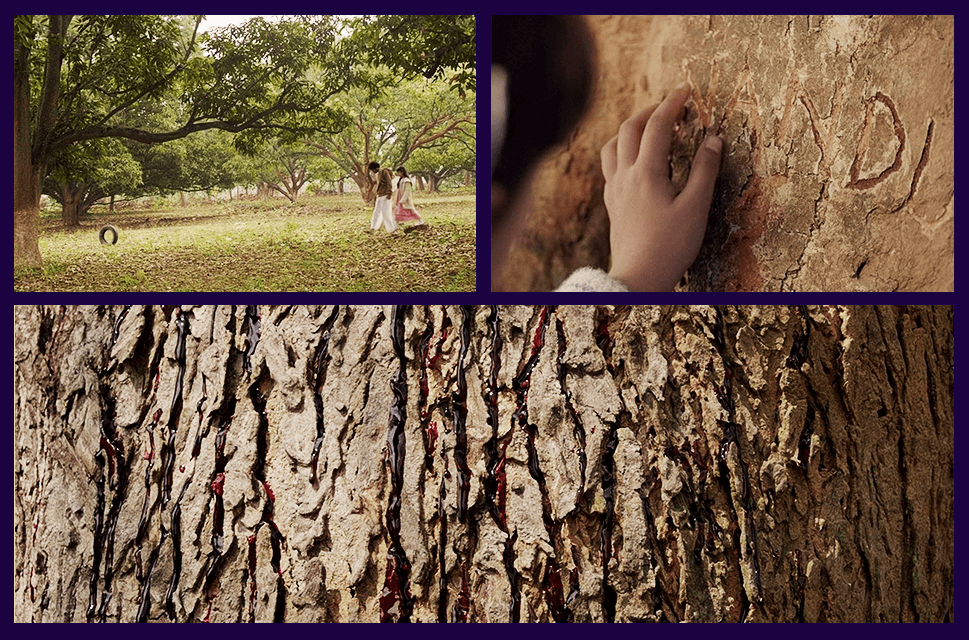
A Death in the Gunj is centered around the character of “Shutu” – a docile, timid and reserved character in the film whose existence is not very significant to others in the family. In fact it’s almost heartbreaking to see him being neglected for most part of the film. There’s just one character who has stayed with him majorly i.e. “Tani”
While he and Tani were playing in the fields near the house, Tani searches for the family tree and soon as she finds it she checks the whole tree and reads the names of all family members one by one. She very innocently asks Shutu that why his name is missing on the tree. Shutu knows why it’s not there and knows how he is treated like an outcast, but he gently dismisses poor Tani by distracting her.
His name not being there was a pretty clear sign that he was never considered a part of the family, neither was he treated like that. That is why throughout the film one feels the sorrow for Shutu as a viewer, your heart goes out to him.
The third frame is one of the most hauntingly beautiful frames we have seen in contemporary Hindi films. The blood is dripping and sliding all over the tree veins and is shown for a few chilling seconds. *Spoiler Ahead*
We all know (or at least can safely assume) that it’s Shutu’s blood, but his face or body was never shown after that. Our interpretation is that through this frame it’s reassured that Shutu could never have been a part of that family tree but it’s only soul-crushing to see him imprint his presence this way on the tree.
10. Satya (1998)
Satya was Ram Gopal Varma’s marvelous attempt at showing us the consequences of taking violence as a means of living. And the film was appreciated by the masses as they related with it as something which was very close to reality and was like a mirror to the underworld in Mumbai during those times. RGV was able to capture the essence of Mumbai in the film through different aspects – right from the lingo to the characters to the sea, everything was on point. But one more quintessentially Mumbai flavoured tool was the Ganapati Visarjan. The iconic visarjan scene is considered as one of the grittiest scenes in the hindi films.
These scenes were #PausedOnPurposeto show how cinema resorts to such cultural tropes to design violence aesthetically. The final scene of the film is when Satya goes to kill Bhau. It’s Ganesh Visarjan – the biggest festival in the city that embellishes the seashores of Mumbai. The vibe is super chaotic, just what Mumbai is known for. Bhau, after winning the election, is celebrating at the Visarjan. Satya, poised yet full of angst, walks towards him amidst the chaos of the festival, with Sandeep Chowta’s chilling background score of stotra (Hindu chant) playing. And we see the inevitable yet stunning sequence of Satya stabbing Bhau. It gives an oddly satisfying feeling to the viewers even though we know that each and every person in the contention is wrong, including Satya.
The takeaway for us here could be how using such cultural and local references in a piece of craft can elevate its level and connect with the audience better. And it’s pleasing to see irony used to their advantage i.e. making an impact by using festivals (which are meant for unity, peace and harmony) blending it into a well designed violent scene.
Think you can make such keen observations from films like nobody else? Share your writings with us and get featured on India Film Project. Download the IFP app, make your profile, head to the PARTICIPATE section and start sharing your observations![/vc_column_text][/vc_column][vc_column width=”1/12″][/vc_column][vc_column width=”3/12″ css=”.vc_custom_1587562979413{border-left-width: 5px !important;padding-right: 10px !important;padding-left: 10px !important;background-color: #f5f5f5 !important;border-left-color: #1e73be !important;}”][vc_column_text css=”.vc_custom_1587562951408{margin-right: 20px !important;margin-left: 20px !important;border-right-width: 20px !important;border-left-width: 20px !important;}”]
Continue Reading
[/vc_column_text][vc_basic_grid post_type=”post” max_items=”5″ element_width=”12″ gap=”35″ item=”10912″ grid_id=”vc_gid:1587562955718-e1507b40-1b1c-7″ el_class=”grp”][/vc_column][/vc_row][vc_row full_width=”stretch_row_content_no_spaces” gap=”10″ equal_height=”yes” content_placement=”top” css=”.vc_custom_1559458142539{background-color: #1b0341 !important;}”][vc_column width=”1/4″][vc_column_text]50 HOUR FILMMAKING CHALLENGE
Know More
Rules
FAQs
Jury
Awards
Previous Winners[/vc_column_text][/vc_column][vc_column width=”1/4″][vc_column_text]
CHALLENGES
Short Scriptwriting Challenge
Storytelling Challenge
Poster Design Challenge[/vc_column_text][/vc_column][vc_column width=”1/4″][vc_column_text]
FESTIVAL
Schedule
On The Stage
Venue and Travel
BUY PASSES[/vc_column_text][/vc_column][vc_column width=”1/4″][vc_column_text]About IFP
Previous Editions
Branded Content
Labs
Campus Connect
HELPLINE – 9727299070
EMAIL – [email protected][/vc_column_text][/vc_column][/vc_row]

